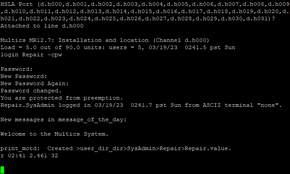Multics
 | |
| Developer | MIT General Electric (defunct, merged with GE Aerospace in April 2024) Bell Labs Honeywell (after 1970) |
|---|---|
| Source model | Open source |
| Initial release | MR1.0 (1969) |
| Latest release | MR12.8 (10 August 2023) |
| Supported platforms | GE645/DPS8 |
| License | MIT |
Multics (Multiplexed Information and Computing Service) is a time-sharing operating system originally designed by MIT, Bell Labs and General Electric for the GE-645 mainframe computer. It is considered one of the most influential operating systems of all time and was the main inspiration for Unix.
History[edit | edit source]
Multics started development around 1964 for General Electric's then-upcoming 36-bit GE-645 mainframe. Its predecessor, the GE-635, was shipped with "Mark I", an earlier time-sharing system made by the aforementioned company. The first Multics papers were released in 1965, and the first GE-645 unit running Multics was shipped to MIT in 1967. Bell Labs exited the project in 1969, and GE sold its computer division to Honeywell in 1970. Around 1973, Multics began shipping with the Honeywell 6180 (DPS-8) mainframe, which was based on the GE-645.
Honeywell continued Multics development until 1985, about 80 systems were installed worldwide by then. Usage of Multics diminished by the 90s, with faster and lower cost computing options available. The last Multics system, located in Halifax, was shut down in 2000.
The source code of MR12.5, the last commercial release of Multics, was released in 2007. This allowed Multics enthusiasts to continue development of Multics. Version MR12.6f was released in 2017, alongside the SIMH-based DPS-8 simulator.
Features[edit | edit source]
- Multics was the first operating system to support a hierarchical file system. In addition, it supported long names and multiple names for segments, as well as symbolic links.
- Dynamic linking is introduced. It allows processes to make external subroutines available to it just by loading the segment it's contained in.
- On-line reconfiguration is supported, the CPU, memory and disks could be added or removed while the operating system kept running.
- Several modern security systems were first implemented in Multics, and it had support for ring-based security.
- It was one of the first operating systems to be written in a high-level programming language, known as PL/I.


